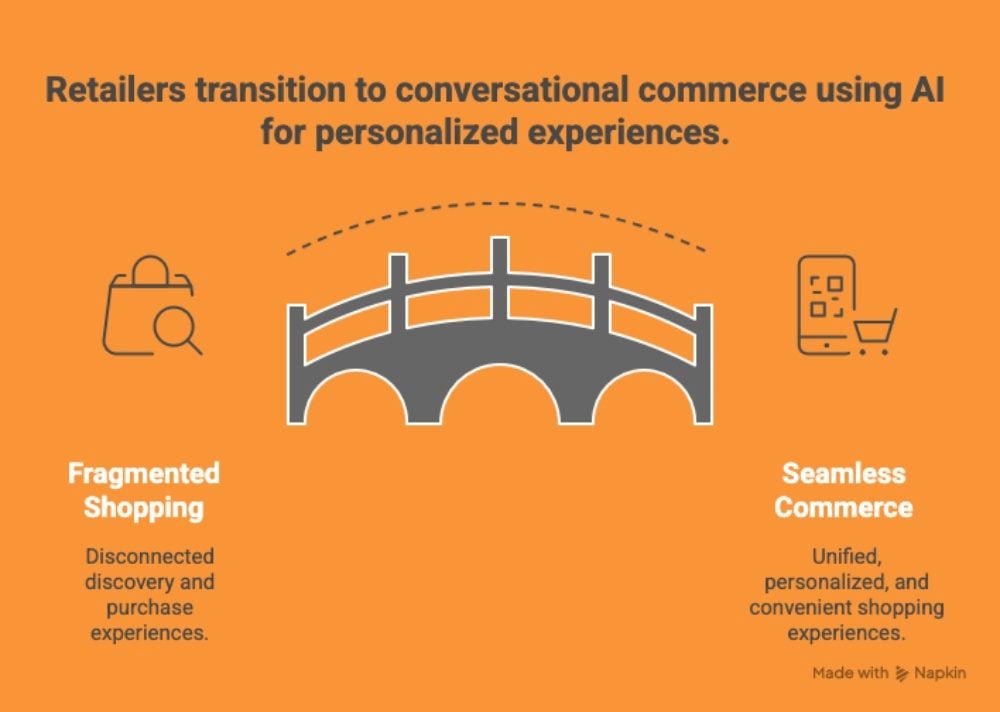How OpenAI’s new shopping feature will fundamentally reshape customer experience expectations in ecommerce and retail.
The Gist
- Instant Checkout transforms ChatGPT into a commerce platform. Users can now buy directly from Etsy and over one million Shopify merchants without leaving a conversation—collapsing the traditional ecommerce journey into a chat-to-checkout experience.
- Frictionless buying raises new CX expectations. Merchants retain order control, but customers will expect conversational ease across all post-purchase support channels.
- Agentic commerce reshapes trust and transparency. As AI gains more autonomy in purchasing, CX leaders must redefine safeguards, metrics, and relationship ownership in a world where experience becomes inseparable from conversation.
Since its November 2022 launch, ChatGPT has become synonymous with general AI capabilities. Now OpenAI is extending its influence toward a new frontier: ecommerce.
OpenAI has officially transformed ChatGPT from a discovery tool into a complete commerce platform with the launch of Instant Checkout, powered by the Agentic Commerce Protocol developed in partnership with Stripe. Starting with U.S. Etsy sellers and expanding soon to over one million Shopify merchants, including Glossier, SKIMS, Spanx, and Vuori, this development represents more than just another checkout option.
It is a fundamental reimagining of the customer experience journey that could have been implications on the customer experience industry.
Customer experience professionals in e-commerce and retail recognize OpenAI’s entry as a signal that the entire paradigm of how customers discover and purchase products is shifting toward agentic commerce — online shopping managed with AI.
Table of Contents
- What OpenAI Is Offering: Instant Checkout Explained
- The Friction-Free Promise: What Changes for CX
- How Does Instant Checkout Work?
- The Trust Equation: Transparency in a Black Box
- Merchants as Merchants of Record: Preserving Relationship Ownership
- The Context Advantage: Memory and Personalization
- Multi-Item Carts and the Future of Agentic Commerce
- The Discovery-to-Purchase Continuum Collapses
- The Larger Context: Commerce at the Conversation Layer
- Measuring Success in Conversational Commerce CX
- The Questions That Remain
What OpenAI Is Offering: Instant Checkout Explained
Instant Checkout enables ChatGPT users to complete purchases without leaving the conversational interface. When someone asks a shopping-related question—”best running shoes under $100″ or “gifts for a ceramics lover”—ChatGPT displays relevant products from across the web. For items where Instant Checkout is enabled, users see a “Buy” button that lets them complete the entire transaction within the chat.
How Instant Checkout Collapses the Ecommerce Journey
The technical foundation is the Agentic Commerce Protocol, an open-source standard co-developed with Stripe that OpenAI is making available to any merchant or developer. This protocol creates a secure payment framework where ChatGPT acts as the user’s AI agent, passing information between customer and merchant while the merchant retains full control as the merchant of record. Merchants handle orders, process payments through their existing systems (Stripe or otherwise), manage fulfilment and own the customer relationship post-purchase.
Currently supporting single-item purchases for U.S. users of the Plus, Pro, and Free tiers, OpenAI plans to expand to multi-item carts and additional regions. The company emphasizes that product recommendations are organic and unsponsored, ranked purely by relevance, with merchants paying a small transaction fee on completed purchases. For customers, the service is free and doesn’t affect product prices. ChatGPT Plus and Pro subscribers can leverage saved payment methods and shipping details for even faster checkout, though all users must explicitly confirm each step before purchase.
This represents OpenAI’s first major move toward what they call “agentic commerce”—a platform where AI doesn’t just help you find products but actively facilitates purchasing them on your behalf, with the long-term vision of more autonomous shopping experiences.
The Friction-Free Promise: What Changes for CX
Ecommerce has long been a goal of every digital platform, from the leaders of internet browsers to social media platforms. Yet the customer journey of most ecommerce attempts often includes friction points for customers to complete a purchase: multiple browser tabs and re-entering payment information, all while having users create an account, can lead to abandoned carts.
Many experts had hoped social commerce – retail through social media – would minimize the friction points. The volume of US social commerce did rise, especially during the COVID-19 pandemic. The rise of direct-to-customer retail placed a spotlight on aligning click-through behaviour and sales, creating high interest in a cart checkout with just a few clicks.
OpenAI’s launch of Instant Checkout approaches a speedy checkout with a “chat to checkout in just a few taps.”
How Does Instant Checkout Work?
Here’s how Instant Checkout works: A customer asks ChatGPT for “gifts for a ceramics lover,” receives curated product recommendations, sees a “Buy” button on items with Instant Checkout enabled, and completes the purchase without ever leaving the conversation. For ChatGPT Plus and Pro subscribers, the platform can prefill shipping and payment details, making the experience even more seamless.
This level of convenience raises the digital customer experience bar significantly.
The Rise of Conversational Shopping Behaviour
If customers can complete a purchase in seconds through conversational AI, they’ll increasingly expect similarly frictionless experiences everywhere else. Retailers who maintain clunky checkout processes will feel the comparison acutely.
The Trust Equation: Transparency in a Black Box
One of the most significant customer experience implications involves trust and transparency. OpenAI emphasizes that product results are “organic and unsponsored, ranked purely on relevance to the user,” and that Instant Checkout availability doesn’t influence product rankings. When multiple merchants sell the same product, ChatGPT considers availability, price, quality, primary seller status and Instant Checkout availability to optimize user experience.
One potential shift for customers is the kinds of trust signals to look while shopping online.
New Trust Signals in an AI-Led Environment
Customers have spent years learning which search results, sponsored placements and algorithmic recommendations to trust. They know when they’re being marketed to. Conversational AI collapses those visual cues. There’s no “Ad” label or comparison shopping pages, verifying that you’re seeing the best options.
Memory as the Engine of Relationship Commerce
This contextual awareness enables product recommendations that feel genuinely helpful rather than algorithmically generic.
For customer experience strategy, this represents a shift from session-based commerce to persistent relationship commerce. Instead of starting fresh with each visit, customers maintain an ongoing dialogue where preferences, constraints and needs are already understood. It’s the digital equivalent of shopping with a personal stylist who remembers your taste, size and budget.
However, this also requires rethinking privacy and consent. OpenAI notes that “to respond to your shopping question, ChatGPT uses your query and available context (such as Memory or Custom instructions).” Customers may not fully grasp how much information they’re sharing through casual conversation or how it’s being used to shape recommendations.
Multi-Item Carts and the Future of Agentic Commerce
Currently, Instant Checkout supports single-item purchases only. OpenAI plans to add multi-item carts and expand merchant and regional availability. But the real customer experience transformation lies in what OpenAI calls “agentic commerce”—where AI doesn’t just help you find what to buy but actually makes purchases on your behalf.
Imagine asking ChatGPT to “stock my pantry with staples I usually buy” or “replace my worn-out workout clothes with similar items” and having it autonomously complete those purchases based on your preferences, budget and past behaviour.
AI Autonomy and the Next Phase of Agentic Commerce
OpenAI emphasizes that “users stay in control—they explicitly confirm each step before any action is taken,” but it’s easy to see how this could evolve toward greater autonomy.
From a CX perspective, this promises ultimate convenience but introduces new anxieties. What happens when the AI makes a wrong assumption? How do you dispute an order you didn’t manually approve? What safeguards prevent accidental purchases during casual conversation? These aren’t theoretical concerns—they’re fundamental customer experience challenges that will need addressing as agentic commerce matures.
The Discovery-to-Purchase Continuum Collapses
Traditional ecommerce has maintained a clear separation between discovery (search engines, social media, content sites) and purchase (retailer websites, marketplaces). ChatGPT collapses this continuum entirely. The same conversation that starts with “how do I decorate a small apartment” can seamlessly transition to purchasing specific furniture pieces without the customer ever consciously entering “shopping mode.”
This fluidity creates immense convenience but also removes traditional decision-making waypoints. In conventional ecommerce, the journey from discovery to checkout includes multiple opportunities for price comparison, reading reviews and specification verification.
Discovery, Purchase and Confidence in One Flow
Conversational commerce compresses these steps, potentially reducing buyer confidence even as it increases convenience.
Savvy retailers will need to ensure their product information, reviews and trust signals are accessible within conversational contexts. If ChatGPT recommends your product, customers should still be able to access detailed specifications quickly, customer reviews, return policies and other information that builds purchase confidence.
Six Strategic Imperatives for Retail CX Leaders
Actions ecommerce and CX professionals can take to prepare for conversational commerce.
| Action | Recommendation |
|---|---|
| Prepare for conversational commerce expectations | Even customers who never use ChatGPT shopping will expect its convenience. Streamline your checkout to minimize steps between discovery and purchase. |
| Ensure your product data is AI-ready | ChatGPT relies on structured data—pricing, inventory, and descriptions—to recommend accurately. Optimize catalogues for AI parsing, not just human browsing. |
| Strengthen post-purchase CX | Make order tracking, returns, and support as effortless as buying through chat. Consider adding conversational AI support on your own channels. |
| Maintain transparent pricing and policies | AI shoppers may buy without visiting your site. Ensure your product feeds include clear pricing, shipping, and return data to prevent confusion. |
| Rethink customer acquisition costs | OpenAI’s per-transaction fees shift focus from ad-driven discovery to conversion-based models. Re-evaluate your acquisition and retention ROI. |
| Plan for autonomous shopping | Prepare for AI-driven, recurring purchases where customer oversight decreases. Define safeguards, limits, and opt-ins to maintain control and trust. |
The Larger Context: Commerce at the Conversation Layer
OpenAI’s move follows a broader trend of commerce functionality migrating to conversational interfaces powered by AI. Meta has been experimenting with business messaging on WhatsApp and Instagram. Google has integrated shopping into search results, hoping to further leverage its AI Overview integration with its search engine.
But OpenAI’s approach—combining product discovery, recommendation and checkout entirely within a conversational AI interface—represents the most complete implementation yet. OpenAI’s decision to open-source the Agentic Commerce Protocol suggests ecosystem ambitions.
Commerce at the Conversation Layer
By creating a standard that works across AI platforms and payment processors, OpenAI is positioning conversational commerce as infrastructure, not just a ChatGPT feature. Marketing professionals must monitor adoption of conversational commerce as an element of marketing strategies and campaigns.
Moreover, competitors who are still finding their AI strategy will see the Agentic Commerce Protocol as a significant competitor. Amazon, for example, has long offered shopping capabilities with Alexa. But partners in the Alexa ecosystem may move toward Open AI if Amazon does not launch a similar AI protocol for Alexa.

Measuring Success in Conversational Commerce CX
Traditional ecommerce metrics—bounce rate, cart abandonment, time on site—don’t translate cleanly to conversational commerce.
Metrics That Redefine Success in Conversational Commerce
New ways to measure engagement, conversion and satisfaction when shopping happens inside AI conversations.
| Metric | Definition |
|---|---|
| Recommendation acceptance rate | Percentage of purchases made from ChatGPT’s initial suggestions versus alternatives. |
| Conversational conversion | Ratio of shopping-related prompts that end in a completed transaction. |
| Repurchase through conversation | Share of customers returning to ChatGPT for repeat or follow-up purchases. |
| Post-purchase satisfaction | Customer-reported satisfaction after buying through ChatGPT, including fulfilment and support quality. |
| Preference drift | How accurately ChatGPT adapts to a customer’s evolving preferences and feedback over time. |
These metrics will help retailers understand whether conversational commerce delivers genuine CX improvements or simply novelty-driven early adoption.
The Questions That Remain
OpenAI’s Instant Checkout raises as many customer experience questions as it answers:
How will product returns work when the purchase was made conversationally? Can customers modify orders placed through ChatGPT? What happens when products are out of stock after ChatGPT recommends them? How do subscription services and recurring purchases translate to conversational commerce? What safeguards prevent accidental purchases during ambiguous conversations?
These implementation details are fundamental to whether conversational commerce is a fit for the seamless customer experience being sought. Marketers should consider whether the answers mean achieving the promised experiences or are an indicator of implementation frustrations.





